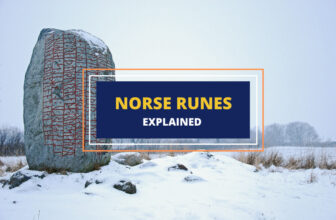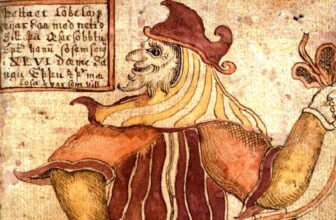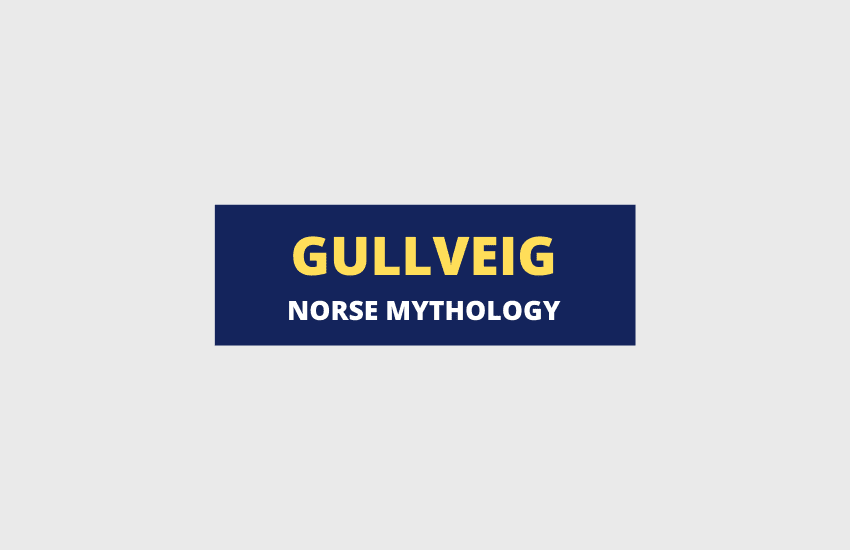
Table of Contents
Gullveig is one of those special characters in Norse myths and legends that is scarcely mentioned but yet plays an important role. The subject of endless speculation, Gullveig is a character that led to one of the biggest wars in Asgard and changed the landscape of the realm of the gods forever. It’s unclear who Gullveig is exactly. Is she a traveling witch, the reason for the first war, and freyja in disguise?
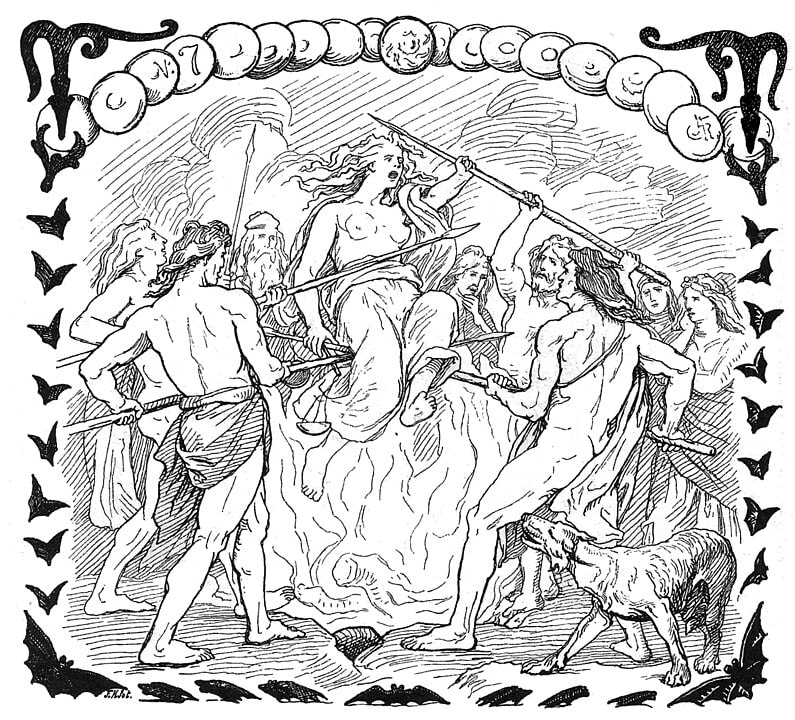
Who is Gullveig?
Gullveig is mentioned in only two stanzas in the Poetic Edda. Both of these mentions precede the story of the great Vanir-Æsir War and seem to cause it directly.
In those two stanzas, Gullveig is called a witch and a practitioner of the feminine seidr magic. When Gullveig visits Asgard, the realm of the Æsir gods led by the Allfather Odin, she both impressed and horrified the Æsir gods with her magic.
One of the two stanzas reads:
When she came to a house,
The witch who saw many things,
She enchanted wands;
She enchanted and divined what she could,
In a trance she practiced seidr,
And brought delight
To evil women.
Immediately, this describes what most people today know as the witches from the accumulative European folklore. And the response of the Æsir gods in the Poetic Edda was exactly what people did to witches – they stabbed her and burned her alive. Or, at least they tried to:
When Gullveig
Was studded with spears,
And in the hall of the High One [Odin]
She was burned;
Thrice burned,
Thrice reborn,
Often, many times,
And yet she lives.
What is Seidr Magic?
Seidr, or Seiðr, in Norse mythology is a special type of magic that was practiced by many gods and beings in the later periods of the Scandinavian Iron Age. It was mostly associated with foretelling the future but it was also used in shaping things to the magician’s will.
In many stories, seidr is associated with shamanism and witchcraft. It also had other practical applications, but these aren’t as well defined as future telling and reshaping.
Seidr was practiced by both male and female gods and beings, but it was mostly viewed as a feminine type of magic. In fact, male practitioners of seidr, known as seiðmenn, were often persecuted. Their dabbling in seidr was viewed as taboo while women seidr practitioners were mostly accepted. That appears to be the case in the later Norse periods – in earlier stories such as the one about Gullveig, female “witches” were also maligned and persecuted.
Like the more well-known European witchcraft, seidr was used both for “good” and “forbidden” things. As Gullveig’s stanzas explain, she enchanted and divined things and she also brought delight to evil women.
The most well-known seidr-practicing gods were the Vanir fertility goddess Freyja and the Allfather god Odin.
Who Were the Vanir Gods?
The Vanir gods in Norse mythology were a separate pantheon of gods to the more famous Æsir gods from Asgard. The Vanir lived in Vanaheim, another one of the Nine Realms, and were an overall much more peaceful tribe of deities.
The three most famous Vanir gods were the god of the sea Njord and his two children, the twin fertility deities Freyr and Freyja.
The reason for the separation of the two Vanir and Æsir pantheons in the otherwise joint Norse mythology is likely that the Vanir were initially worshipped in Scandinavia only while the Æsir were worshipped more broadly across Northern Europe.
As the people worshipping both pantheons kept interacting and mingling over the years, the two pantheons eventually combined. However, this merging of the two pantheons began with a great war.
The Start of the Vanir-Æsir War
Called the First War, as detailed in the works of the Icelandic author Snorri Sturluson, the Vanir-Æsir War marked the collision of the two pantheons. The war began with Gullveig, who played a crucial role in getting it started. It eventually ended with a truce and with the Æsir accepting Njord, Freyr, and Freyja in Asgard.
As Gullveig is viewed as a goddess or another type of being belonging to the Vanir pantheon, the Vanir gods were furious with the Æsir’s treatment of her. On the other hand, the Æsir stood behind their decision to (try and) burn Gullveig to death as they weren’t familiar with seidr magic yet and viewed it as something evil.
Curiously enough, nothing else is said about Gullveig after the start of the Vanir-Æsir War even though it’s specifically said that she survived all three of the burning attempts by resurrecting herself over and over again.
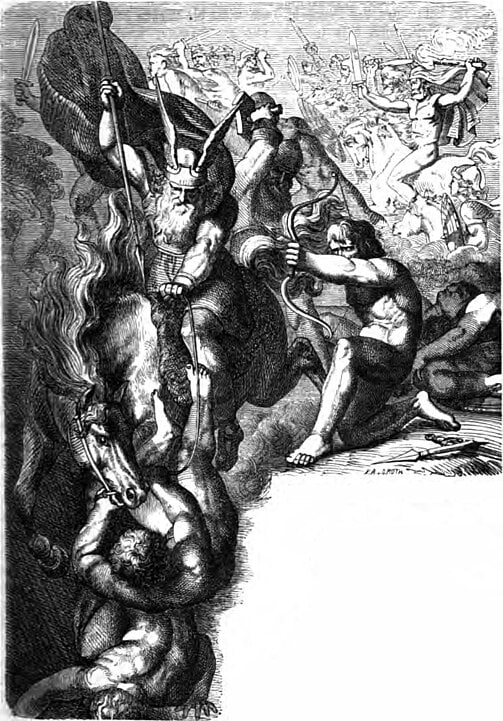
Is Gullveig Another Name for the Goddess Freyja?
One of the prevailing theories for why Gullveig isn’t mentioned at all once the war starts is that she was actually the Vanir goddess Freyja in disguise. There are multiple reasons why that might be true:
- Aside from Odin, Freyja is the most famous practitioner of seidr magic in Norse mythology. In fact, it is Freyja who teaches Odin and the other Æsir gods about seidr after the war.
- While Freyja isn’t the Norse goddess of life and rejuvenation – that title belongs to Idun – she is a fertility goddess in both sexual and farming contexts. The link from that to self-resurrection isn’t that much of a stretch.
- Freyja is also a goddess of wealth and gold. She is said to weep tears of gold and she’s also the wearer of the famous golden necklace Brísingamen. This is a key connection with Gullveig. The name Gullveig in Old Norse literally translates to Gold-drunk or Drunk with wealth (Gull meaning gold and veig meaning intoxicating drink). What’s more, in one of the stanzas, Gullveig is also given another name – Heiðr which means fame, bright, clear, or light which could also be references to gold, jewelry, or Freyja herself.
- Last but not least, Freyja is well-known in Norse mythology as a goddess who frequently travels disguised around the Nine Realms, using other names. This is something Odin is also famous for as are the patriarch/matriarch deities in many other pantheons and religions. In the case of Freyja, she usually roams around in search of her often-missing husband Óðr.
Some of the names Freyja is known by include Gefn, Skjálf, Hörn, Sýr, Thrungva, Vanadis, Valfreyja and Mardöll. While neither Gullveig nor Heidr are part of that list, maybe they should be. There’s nothing in Gullveig’s two stanzas that indicate she’s not Freyja in disguise and that theory could explain why the mysterious seidr witch is not mentioned in Norse legends after the war.
Symbolism of Gullveig
Even in her two short stanzas, Gullveig is shown to symbolize multiple different things:
- Gullveig is the practitioner of a then-mysterious and new magical art the Æsir gods had never seen before.
- She’s one of the oldest examples of the witch archetype in European culture and folklore.
- Even just with her name, Gullveig symbolizes gold, wealth, and greed, as well as the ambivalent attitude that the Norse people had towards wealth – they viewed it both as something good and desirable, as well as something disruptive and dangerous.
- With Gullveig getting repeatedly staked with spears and burned alive, she exemplifies the classic witch-burning trials that became so horrifically practices by people in Europe and North America centuries later.
- The myth of resurrection is explored by most cultures and religions in one form or another. Gullveig’s ability to come back to life numerous times after being burned, symbolizes resurrection.
- Just like Helen of Troy in Greek mythology who started the Trojan War, Gullveig became the cause of one of the biggest conflicts in Norse mythology – that of their two major pantheons of deities. But unlike Helen of Troy who just stood there, being pretty, Gullveig personally brought two different cultures together and made their rituals and worldviews clash.
Importance of Gullveig in Modern Culture
You’d be hard pressed to find the name of Gullveig used anywhere in modern literature and culture. In fact, even in the preceding 20th, 19th, and 18th centuries, Gullveig is almost never mentioned.
Her likely alter-ego Freyja, however, is more well-known as is the cultural trope Gullveig helped start – that of witches and witch-burning.
Wrapping Up
Gullveig is only mentioned twice in Norse mythology, but it’s highly probable that she was simply the Vanir goddess Freya in disguise. The associations are too many to ignore. Regardless, Gullveig’s role as the one who indirectly put the Aesir-Vanir war into motion makes her an important figure, who remains the subject of much speculation.





